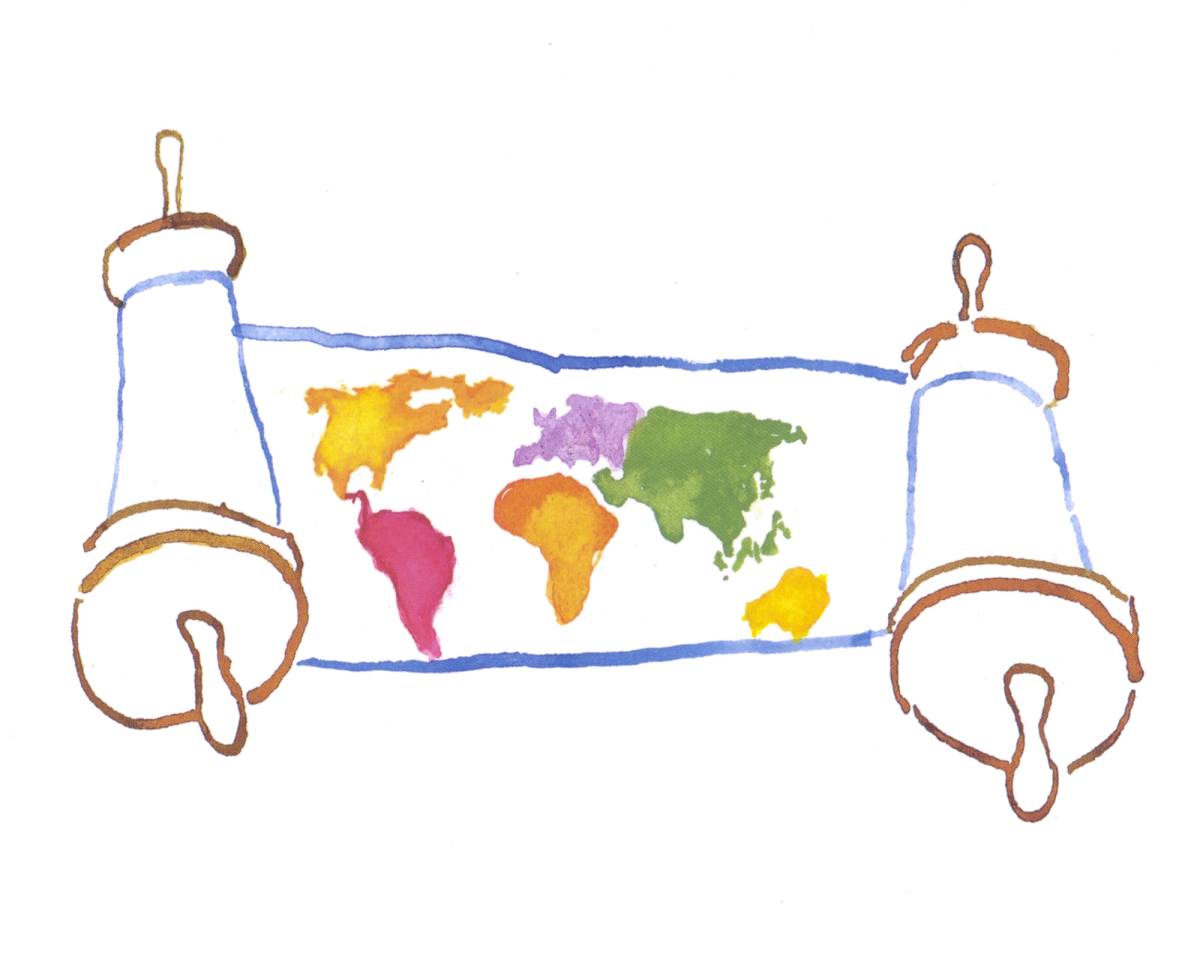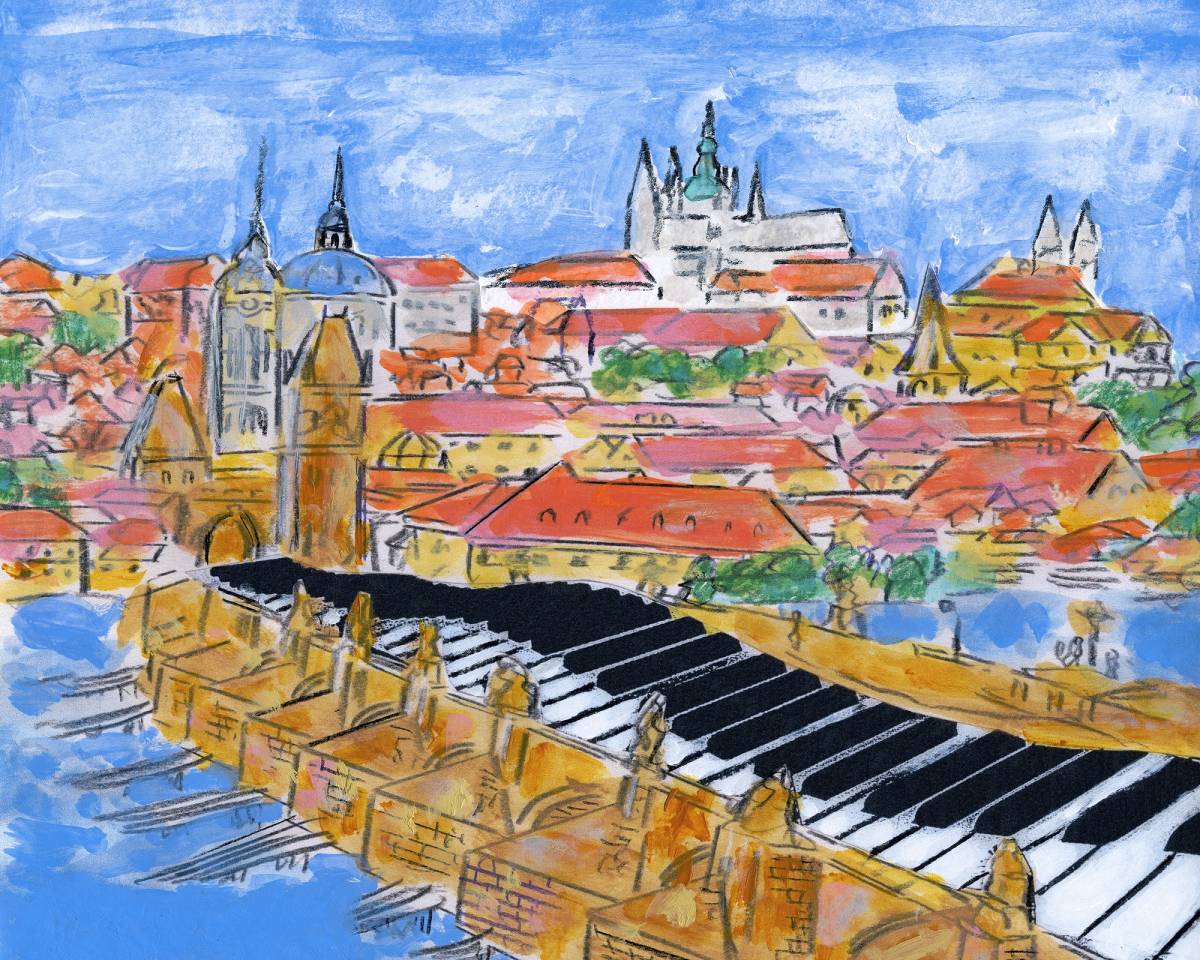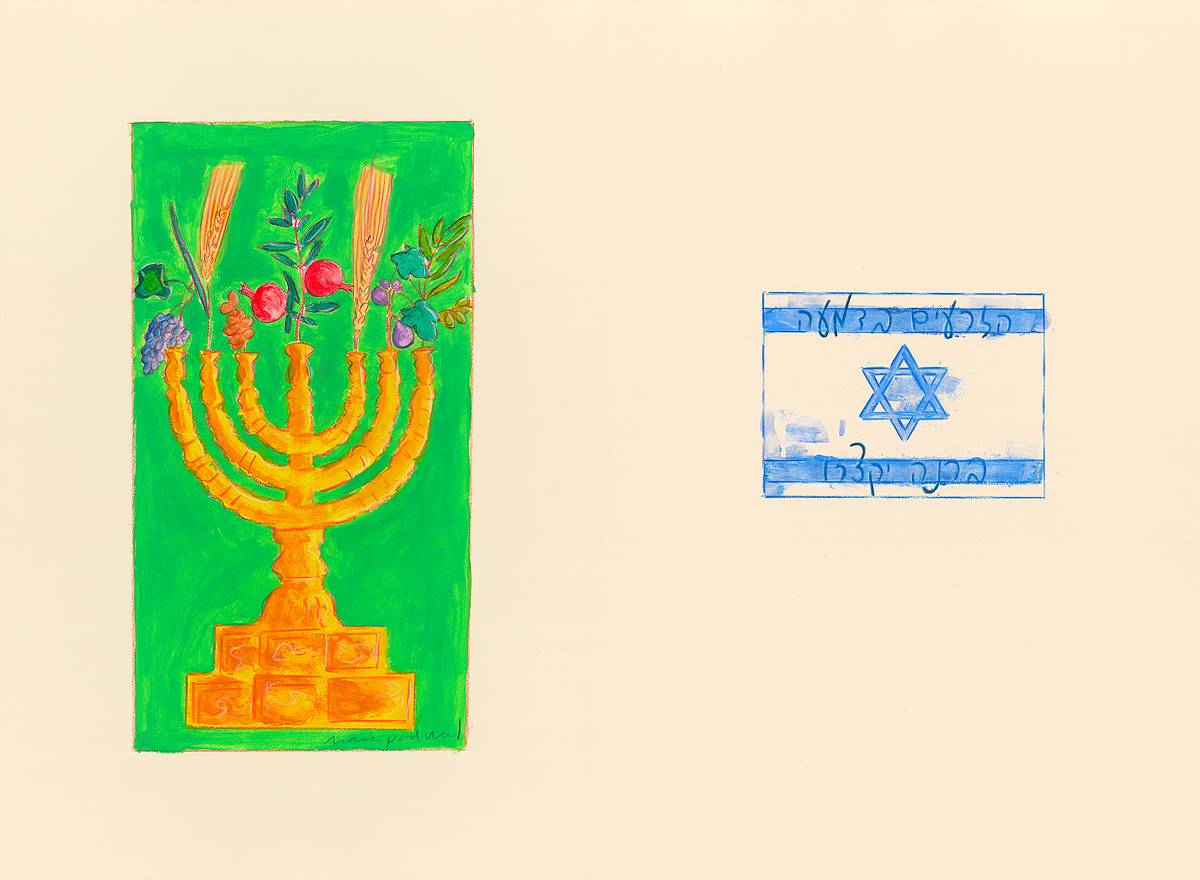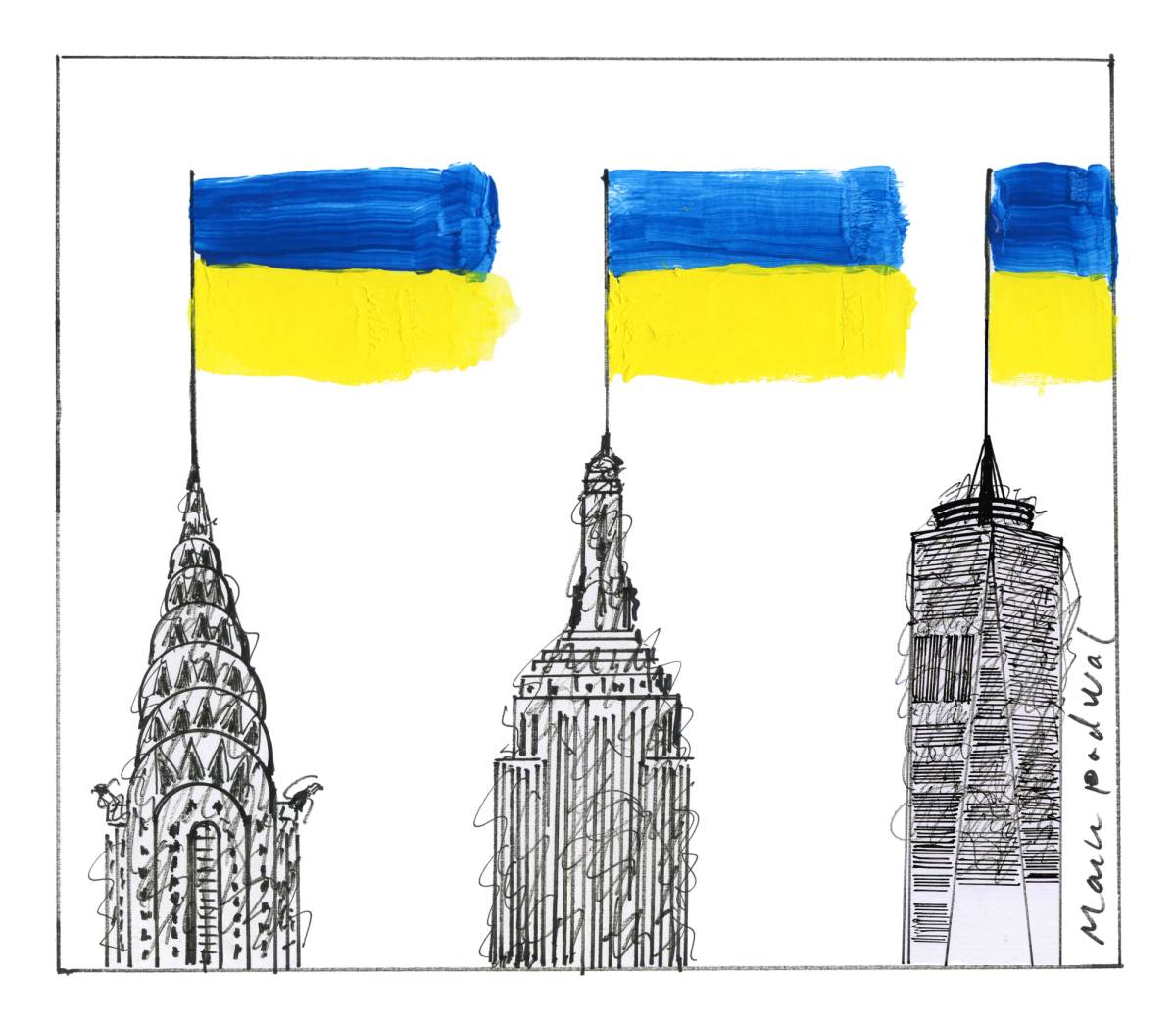
On Rosh Hashanah, this marvelous New Year’s greeting from Mark Podwal popped up in my inbox. The drawing is a celebration of our world in its glory, colors, form, its natural beauty and its man-made dilemmas, all wrapped up within the Torah. Or in other words, it is a celebration of “olam”—the world here and now and the world to come—and “tikkun olam,” our obligation to repair this world through kindness, justice, giving, and ethical behavior.
This picture, steeped in Jewish values, is an excellent expression of Mark Podwal’s creative life.
With no formal art training and only one year of Hebrew school under his belt, Mark became an eminent physician and one of our foremost American Jewish artists. I have spent hours with Mark, listening to stories, asking questions, looking at pictures, and learning about his career in art and medicine.
It was unthinkable for a smart Jewish boy after WWII to choose art as a career; medicine or law was expected. Mark chose medicine (dermatology, to be specific) but he continued to draw. In 1972 as a resident at NYU School of Medicine, Mark had his first drawing published on The New York Times op-ed page. The massacre of 11 Israeli athletes at the Munich Olympics had heralded a new wave of international antisemitism, anti-Israel antagonism, and tension between a Jewish olam and a greater world who again sought to annihilate our people. Mark’s response was this drawing—a faceless young athlete, running forward through a classical arch honoring the past, stopped dead in his track by an outpouring of blood. The words crowning the arch are the words of the Kaddish, a prayer we say in mourning but one that never mentions death and only exalts the Almighty.
After Elie Weisel saw one of Mark’s drawings in the Times, he wrote to him, beginning a lifelong friendship and professional collaboration. In 1997, Wiesel accompanied Mark on a visit to an exhibition in Prague, where they went to services together.
Mark recounted, “I started coming to Prague a few times a year, first for the High Holy Days, for Purim—and then almost every month. I attended services at the Altneuschul. In Prague I feel closest to my Jewish roots.” This drawing of the Altneuschul, where Mark continues to pray, in a seat with his name plate, captures the long history of the Old/New Synagogue. Completed in 1270, it is Europe’s oldest active synagogue. Hebrew letters fly out of the still sturdy medieval Gothic structure as if the entirety of Jewish learning is spreading from here across the heavens and the Earth. Olam. In 2011 Mark was commissioned to design all the textiles for the synagogue, Shabbat, and for the holidays.
Also a music lover, Mark frequently attended the opera in Prague, especially in the Estates Theatre where Mozart’s Don Giovanni and La Clemenza di Tito both had world premieres. Nowhere else was the composer as beloved as in Prague. Upon his death in 1791, Mozart’s memorial service in Prague drew thousands of mourners, with music performed by an orchestra of hundreds of musicians who accepted no pay for their efforts.. The collision of Mozart and Prague and Podwal resulted in the 2016 celebration of Mozart and Prague presented in the Klementinum, the Czech National Library.
For this, Mark produced a magnificent portfolio of 27 archival pigment prints, depicting the complicated history of Mozart’s relationship with ecclesiastical, political, and musical authority, as well as creative allusions to episodes from the composer’s time in Prague, his fondness for Bohemia, it’s culture and musical traditions. One evening, the cast who were rehearsing for a film about Mozart showed up in full dress costume at the Klementinum to regale Mark and admire the original Mozart manuscripts and scores on display.

Mark recalled that, “Prior to the opening reception speeches, a quartet was playing Mozart—I had not yet decided what I would say in my remarks. And then it came to me: With this exhibition of Mozart in Prague, I finally left the Prague ghetto!” There was a 9-foot banner outside, cards, and T-shirts for sale. In 2019 he was awarded the Gratias Agit Award, the highest honor of the Czech Foreign Ministry, for his artistic contribution to the nation. This arresting image depicts the city of Prague as it has remained over the centuries with Mozart’s piano keyboard splayed across the Charles Bridge. It sings out with life.

Podwal’s musical work extends beyond Prague. “I knew Peter Gelb and began working for the New York Metropolitan Opera many years before the Mozart and Prague exhibition. In the past the Met had a relationship with artists. Chagall and Hockney and others. Peter Gelb asked me to do something for them. I started with five portraits of Mozart as his operatic characters, then notecards, then the Mozart posters. I now have 10 posters up in the Met shop, illustrating seven of Mozart’s most famous operas and of course Verdi’s Nabucco, the Jewish opera. The latest addition is for Aida.”

In addition to his drawings and paintings, Mark has illustrated dozens of books, some written with other authors like Elie Wiesel, Harold Bloom, and Francine Prose, others researched and written alone. Cynthia Ozick praised his artistry in a laudatory essay and Mark’s drawings in turn have been selected to accompany her poetry. The Metropolitan Museum of Art produced Seder plates, jewelry, prints, and holiday cards with his images. His projects delve into the mysteries of Jewish mysticism, the whimsy of a Jewish bestiary, the magic of Jewish visions and a Kaddish for his mother’s shtetl in Poland. Some of the work is joyful, some somber.
The Terezin portfolio, completed in 2014, is composed of 42 archival prints that recount the long history of systematic antisemitism over the centuries, from biblical Egypt to the Babylonian exile, Greek and Roman desecrations and occupations, the medieval Crusades, scapegoating of Jews during the Black Plague, the Inquisition, blood libel accusations, ghetto life, and discriminatory laws, culminating in the Nazi Holocaust. He ends the series with Psalm 126 celebrating the return of the Jewish people to their homeland from worldwide diaspora, in peace.

“What’s new?” I asked Mark the last time we spoke. “This past spring in 2022 when Russia invaded Ukraine, I went back to political drawing. I did the Ukraine flag flying in solidarity from the spires of New York City skyscrapers.”

Now we have come full circle, traversing the centuries and the globe, returning to tikkun olam and inspiring us to consider our damaged world. In the face of it all, we shoulder our obligation to do our best, by creating some beauty and harmony and assuming the burden of personal responsibility to make the world just a bit better. Mark Podwal’s art is most definitely an act of tikkun olam. He is an artist for our world.
Ruth Oratz is a Professor of Medicine at NYU Langone Medical Center.